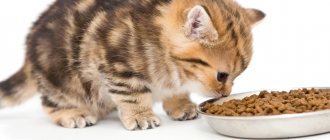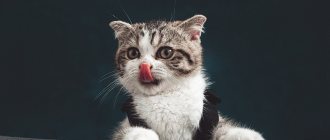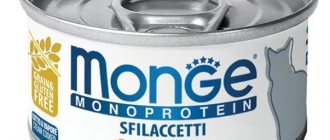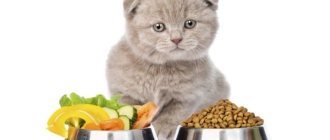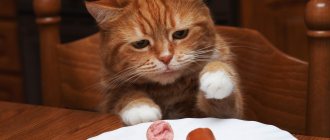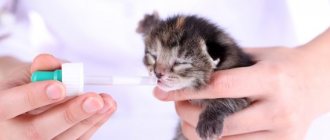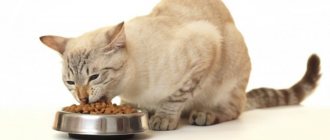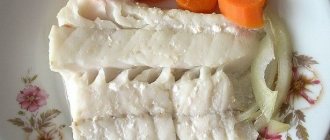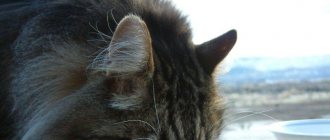Features of the diet of cats
Pet owners who choose a natural type of feeding should be aware that such a diet does not imply feeding cats dishes from the human table. Food must be prepared specifically for the animal, be balanced and completely satiate the pet.
A natural diet for cats is not food from the human table, but specially prepared dishes
Important components of a cat's diet
Proper nutrition serves as a source of physical energy for the animal, normalizes metabolism, promotes the formation of bones and all body systems, and fur growth. A furry pet’s diet should contain a sufficient amount of not only proteins, carbohydrates and fats, but also vitamins and beneficial microelements. A healthy and active individual should receive at least 10 g of protein, 2 g of fat and 2 g of carbohydrates per kilogram of its weight. In accordance with these standards, you need to make a diet.
According to the advice of experts, with a natural diet, the amount of daily food should not exceed 7.5% of the pet’s weight: if the animal weighs 4 kg, then it should receive no more than 300 g of food.
Squirrels
Representatives of cats are predators, and in nature the basis of their diet is meat, and this is one of the main sources of protein. Animal proteins, which are the main element of eggs, meat, cottage cheese and kefir, are better digestible. These foods should make up more than half of the total daily diet.
Carbohydrates
Known primarily as a source of energy, carbohydrates are also beneficial for the proper functioning of many organs and systems. For example, glucose is necessary for brain and kidney function, and carbohydrate fiber promotes normal bowel movements, helps eliminate toxins and gives a feeling of fullness. In the diet of an adult cat, the daily proportion of carbohydrate food should be approximately 50 g.
Fats
Another source of energy is fats, which are also suppliers of vitamins, which include:
- A - for vision, normal condition of the skin and fur;
- D - for bone formation;
- E - for muscles and normal functioning of the reproductive organs;
- K - to strengthen bones, ensure normal blood clotting and calcium absorption.
The sufficient presence of fats not only improves the taste characteristics of food, but also contributes to better growth and development of the animal. The proportion of fat in the diet should be approximately 20%.
The lack of vitamins D and A can be compensated for by fish oil - it should be added directly to food in a few drops. Pharmacies also have special multivitamin complexes - Polidex Immunity up, Doctor Zoo, Radostin.
To ensure that your cat receives all the necessary nutrients, you can give him vitamins.
Microelements and vitamins
A balanced diet is not only a sufficient presence of proteins and carbohydrates, but also vitamins and useful elements. Premium ready-made food already contains the required amount of all important elements, but with a natural feeding regimen, food must be additionally enriched with vitamin and mineral supplements. A special herb is also a source of useful substances, mixtures for germination of which can be found in veterinary stores.
Weed for cats contains beneficial elements
In addition to fat-soluble vitamins, the animal also needs water-soluble vitamins C and B vitamins. Vitamin C, which is involved in hematopoiesis, the production of antibodies, improves resistance, and fights aging, is produced by the cat’s body independently. Its deficiency in kittens and old cats is compensated by the presence of fermented milk products and carrots in the diet.
A lack of B vitamins leads to metabolic disorders, weight loss, poor coordination and hair loss. By-products will help compensate for the deficiency of these vitamins; for the same purpose, you should enrich the diet with a solution of brewer's yeast.
Microelements also play an important role in ensuring normal life. A cat needs potassium, manganese, taurine, iron and iodine, but calcium and phosphorus are considered the most important for its health and development.
Table: microelements necessary for cats
| Microelement | Where is it contained? |
| Potassium | liver, cucumbers and carrots |
| Manganese | buckwheat, rice, carrots and greens |
| Iron | veal liver and eggs |
| Iodine | sea fish, carrots and buckwheat |
| Taurine | poultry, eggs, dairy products and beef |
| Calcium and phosphorus | meat, rice, cottage cheese and kefir |
A lack of vitamins in a cat is manifested by various symptoms - weight loss, lethargy, hair loss, and frequent colds. If there is any change in your pet’s condition, you should immediately contact a specialist who will give the necessary recommendations for enriching the diet.
General rules for feeding your pet
The basics of a proper diet include not only the correct selection of products, but also a competent feeding regimen. As a rule, a kitten appears in the house at the age of 3 months, when it has already mastered the skills of independent living and is accustomed to solid food. Fluffy babies need to be fed at least 5 times a day, by six months you can reduce the frequency of food intake to 3-4 times, after 6 months a pet should receive food 3 times a day, and after a year it is enough to feed an adult twice a day. The volume of the pet's daily portion should be equal to:
- at the age of 3 months - 180–200 g;
- at the age of 4–5 months – 200–240 g;
- at the age of 6 months - 200–250 g.
The calorie content of the diet for a growing and developing organism should be at least 200 kcal, and the energy value of an adult animal's diet should be approximately 80 kcal.
The daily amount of food for large breed pets should be greater. For example, for Maine Coon kittens at the age of three months, the required amount of food is 230 g. When an individual of this breed reaches its adult size, it eats about one and a half times more than a regular cat.
Large breeds, such as Maine Coons, need more food than regular cats.
Following a feeding schedule disciplines your pet and promotes healthy growth and development. By always eating at a certain time, the animal is less susceptible to problems with the gastrointestinal tract and is less prone to begging and stealing from the table. This regime contributes to the formation of a respectful attitude of the four-legged pet towards its owner - the animal ceases to consider itself a completely independent creature and gets used to respecting the order established by man.
Strict adherence to the feeding regime will wean the cat from stealing from the table and begging
Your pet should always have two bowls - the second for water, which needs to be changed in a timely manner.
If after the next feeding there is food left in the bowl, it should be thrown away after 15–20 minutes so that it does not spoil.
The importance of proper diet
Many owners, neglecting the rules of feeding, understand the importance of a balanced diet only when their pet begins to have health problems. It is especially important to follow the regime and correctly formulate the diet when the animal is actively growing and developing. Following the principles of proper feeding helps maintain the health and longevity of your pet. At any age, errors in the animal’s nutrition cause various disturbances in the functioning of the body. The most common health problems caused by poor diet include:
- pathologies of the gastrointestinal tract and joints;
- disorders of the kidneys;
- dental problems;
- allergy;
- urolithiasis disease.
Should food be used raw or cooked?
This is a more complex question than it seems. Some experts recommend raw foods, while others insist on processed foods. The truth is that both types of homemade food—raw and cooked—have benefits for your little furbaby.
The most important factor in protecting your cat's health is a well-balanced diet.
When food is cooked, a lot of natural proteins and nutrients are lost. However, the treatment removes bacteria and other microorganisms that may pose a health risk to the kitten. Since childhood, we have been told about the dangers posed by raw food, such as worms.
But your cat's biology is built entirely around consuming small wild-caught animals. What seems dangerous to you is quite natural to her. The truth is that you can make food from raw ingredients and it will be completely safe for your cats. You just need to be selective with your ingredients and be mindful of food safety.
When meat comes from a healthy animal, it is almost certainly free of any pathogens. Bacteria only exist on surfaces that must be cleaned thoroughly and safely. Internal muscle tissue in healthy animals is free of dangerous microbes.
This is why raw, pre-ground meat is never recommended for kittens. When grinding, microbes are introduced into the muscle tissue, and it is impossible to get rid of them without heat treatment. Therefore, you should grind meat at home, because bacteria will not have time to multiply.
You don't have to choose one: raw or cooked. It is quite possible to find a compromise in preparing cat food. If you are confident in the quality of the raw product, then it is unlikely to harm your cat. However, sometimes it is not necessary to neglect heat treatment.
Remember: your cat is completely dependent on you for all her needs.
Rules for natural nutrition
The undoubted advantage of natural feeding is confidence in the freshness of the cat’s diet and knowledge of its composition, because the owner buys the food and prepares the food himself. But not all owners have the time to prepare culinary masterpieces that are balanced in composition for their pet - and this is the main disadvantage of a natural diet. In addition, animals that eat natural food are prone to developing vitamin deficiency. Therefore, in order to prevent vitamin deficiency, their diet should be enriched with vitamin and mineral supplements. Owners who have made a choice in favor of natural food should know which foods are preferable in the cat’s diet and which should be avoided, and also follow the feeding rules.
Table: healthy and prohibited foods in a cat’s diet
| Approved for consumption | Prohibited for use |
| Lean meats, raw or cooked: beef, chicken, turkey, rabbit | Pork, duck, goose |
| Low-fat boiled sea fish (once every seven days) | Cow's milk |
| Boiled by-products (1–2 times a week) | Freshwater fish |
| Dairy products | Onion garlic |
| Yolk | Spices, salt |
| Vegetables (except prohibited ones) and herbs | Potatoes and legumes |
| Oil – vegetable, olive, flaxseed | Mushrooms |
| Cereals | Bread, pasta, any pastries and sweets |
| Canned food, marinades, any sausage, smoked meats |
Any methods of processing cat food products other than boiling are prohibited. It is allowed to give meat raw, but previously frozen. It should be cut into pieces - very small for a kitten. Oil should be added to porridge or meat 0.5 tsp. 2-3 times a week - this will contribute to better functioning of the gastrointestinal tract. More than half - 60-70% of the total daily diet - should be protein foods - meat, eggs, cottage cheese or kefir. The other part is vegetables and cereals. All pet food should be warm.
What do you need to prepare cat food?
To prepare a cat's dinner, you don't need any special equipment. In the kitchen you will need to have a food processor, blender, and meat grinder, because most products will have to be chopped. There is a basic formula for a cat's diet - half protein (mostly found in meat) and a quarter each of vegetables (they contain fiber) and carbohydrates (these are grains). A large amount of protein is found in chicken, turkey, rabbit and fish. The most optimal source of carbohydrates for animals is brown rice, and for vegetables you will have to rely on what your pet agrees to eat. In your diet, use both boiled and raw meat, mixing it with boiled vegetables and rice.
Dry food recipes
Now we will tell you in detail how to prepare homemade cat food. For the first recipe take:
- kilogram of chicken liver;
- 300 grams of unsalted crackers;
- a large bunch of parsley.
Grind all ingredients as much as possible in a blender or meat grinder. Add a tablespoon of olive oil or fish oil and mix everything thoroughly. After this, place the resulting mass on a baking sheet previously covered with parchment, make a grid with a knife, it is along these lines that you will then break the food into pieces. Bake the food in the oven at 100 degrees for 20 minutes. When the mixture has cooled, divide it into pieces, then return to the oven and dry for another hour.
Another recipe for making delicious dry food for your cat.
You will need:
- 500 grams of beef liver, minced;
- 200 grams of wholemeal flour;
- a tablespoon of honey;
- a pinch of salt.
Mix all ingredients until the consistency of thick sour cream. Next, cook in the same way as in the previous recipe, only at an oven temperature of 150 degrees.
Many pets like this dry food recipe:
- 700 grams of beef liver, minced;
- a tablespoon of small oatmeal;
- two chicken eggs;
- a pinch of salt;
- a tablespoon of vegetable oil.
Mix everything thoroughly and cook as in the first recipe. Here's how to make your cat food she'll love.
Dry food
Dry food from the store is a favorite treat for many pets. However, really high-quality dry food, which contains all the necessary vitamins, nutrients and minerals, is very expensive. But manufacturers of cheap dry food often use low-quality ingredients, caring only about flavor enhancers, so that cats eat their products without getting practically anything useful.
But no one is stopping you from making dry cat food at home. It will be economical, tasty and safe for your pet’s health. To prepare it, take meat or offal; heart, liver, and chicken gizzards are perfect. As auxiliary ingredients you will need rice flour, oatmeal, vegetables, flour, fish oil, bran, vitamin and mineral supplements.
How often should I feed?
Natural food for a domestic cat must also be correct. Therefore, you need to give food several times a day:
- A kitten up to three months of age must be given food six times a day.
- From three to four months, five times a day.
- From four to five months four times.
- From five months to six months three times.
Feeding your domestic cat natural food should be done several times a day. It is not recommended to give food once. When feeding, try to follow the schedule. Give food at the same time every day. It is better to feed an animal with natural food than to give it canned food or dry food.
Before feeding, the food can be slightly warmed and given to the cat in a place where it will not be disturbed. If there are several cats, give them food in different bowls. But cats and dogs should be fed in separate rooms.
“You need to give your cat food even if she constantly catches and eats mice.”
After a meal, the cat needs a good sleep, so you should not disturb it.
The main thing is protein
If you are wondering how to prepare food for your cat, then first of all focus on recipes that are rich in protein. There are quite a lot of them, including some simple ones that won’t take up much of your time, but will allow you to provide your pet with a healthy and balanced diet.
Of course, we should not forget that cats are very picky eaters. Therefore, you cannot guarantee that they will like your cooking; some types of food may not be to their taste. Remember, it is very important for cats that the dish smells delicious. You should never forget about this when deciding what to cook for your cat at home.
